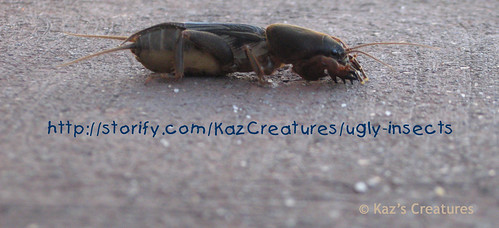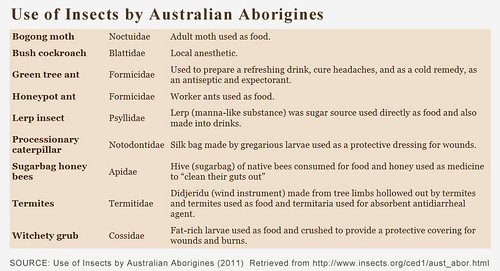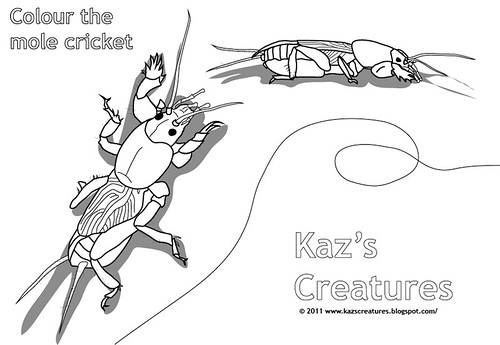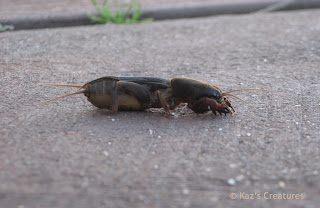The Pitch:
Facing the Music: Surviving Extinction
- Photo: Rod Morris/www.rodmorris.co.nz
Humans are having a major impact reducing survival rates of many species: through the destruction of habitat; introduction of invasive species; pollution; and in the case of some of our most misunderstood and feared creepy-crawlies, purposefully trying to eradicate them.
References:
- Britton, Dave, (2009), Phantom Phasmids, Australian Museum, http://australianmuseum.net.au/Entomology-Collection-Phantom-Phasmids
- Krulwich, Robert, (2012) Six-Legged Giant Finds Secret Hideaway, Hides For 80 Years, Krulwich Wonders, http://www.npr.org/blogs/krulwich/2012/02/24/147367644/six-legged-giant-finds-secret-hideaway-hides-for-80-years
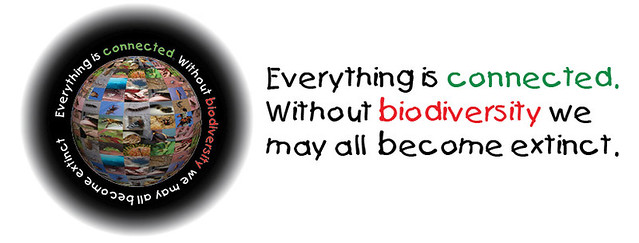
Biodiversity is the variety of ALL things living, from the largest animals and plants to the smallest micro-organisms. It includes all the cute, cuddly, highly publicised animals AND the ugly, frightening creatures.
There are three major categories of biodiversity:
- Genetic Biodiversity – the variations within a species, and between each individual within a species. We are all unique.
- Species Biodiversity – there are a variety of species inhabiting each area. Maintaining the relationship between each and every species is important to ensure the survival of each species.
- Ecosystem Biodiversity – the variety of species interacting to create unique environments or ecological systems: freshwater, marine, forest, grassland, tundra and desert.
"Biodiversity is so vast and so complicated, that biologists still haven't documented most species on our planet"
CALL TO ACTION: FACE THE MUSIC
- Be aware of the species living around you.
- Learn their names.
- Are they native to your area? Are you sure?
- Discover how each species interacts with another?
I encourage you to pay attention to the huge assortment
of organisms that surround you. Be fascinated.
Biodiversity is essential both in its own right and for the survival of the human species. It contributes to healthy soil, waterways and clean air, all which directly and indirectly benefit us. Due to interactions between species, one small change may have a major impact on other species.
The world's economy relies on biodiversity to produce food, water and to break down pollutants. A range of species, ants for example, help maintain soil fertility, recycling nutrients, pollinating plants, and aiding water filtration, which in turn, aids crop production. Other major pollinators of plants include bees and flies, of which Australia has 1500-2000 native bee species and 30,000 species of flies. That’s a lot of insects that are working behind the scenes assisting with our food production!
"There is no factory or technology producing
so much of value at so little cost".
Strong biodiversity aids the economy: Australian National Parks with their many endemic species attract 40% of all international visitors. These nature seeking travellers visit Australia for twice as long as other tourists and contribute to 80% of international tourist dollars. Australia’s recreational fishing industry is estimated to be worth over $2.9 billion per year. Of concern, however is that damage to our biodiversity also damages our economy. Tourists stop visiting, salinity and erosion issues increase, as do costs associated with pollution and climate control.
SOURCE: ("National Biodiversity Strategy Review Task Group," 2009)
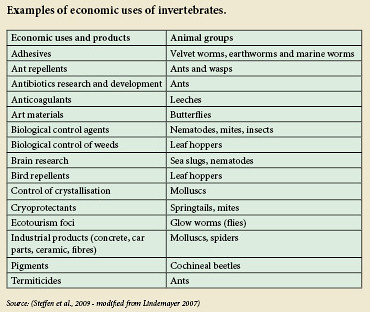
The variety of species has long been a source of inspiration for artists, musicians and technicians. Insects and birds inspire flight and wind resistant technologies. Homes are decorated with nature inspired artworks and constructed from a variety of natural materials. With the diverse range of species on Earth, we are only limited by our imaginations.
- How many species can you name, that directly or indirectly, contribute to the production of food you eat?
- Do you make use of National Parks, local parks or your own backyard as part of your recreational space?
- Will you be reliant in the future on scientists finding a cure to the illnesses you may suffer?
- Are you inspired by nature? Have you considered drawing, photography or creating a piece of music based on nature?
Remember that the greater the biodiversity, the more amazing things we will be able to achieve now and in the future.
Humans are the biggest threat to biodiversity, mostly due to ignorance. The landscape is constantly being changed and destroyed with logging, clearing, mining, poor fire management, urbanisation, introduction of foreign species, landscape fragmentation, and the list goes on. Ecosystems are dynamic in both space and time with changes in one environment potentially having an impact on the other side of the planet.
“The ecological rule of thumb is that when
90 per cent of a habitat is cleared, 50 per cent of its species will be driven to extinction”
90 per cent of a habitat is cleared, 50 per cent of its species will be driven to extinction”
Learn about the species native to the areas you occupy. Observe them in their natural environments and attempt to identify the species. Assistance can be sourced from any number of books, databases or conservation organisations. The more information we know about where and how different species live, the more we can appreciate their uniqueness (like the sound of the motorbike frog, litoria_moorei) and desire to protect them.
To protect biodiversity use products that are environmentally friendly, create nature areas that encourage the survival of local species and contribute to databases recording species your an area. By recording information, we can gauge how threatened a species is, prove its worthiness for protective intervention and make positive changes before it becomes extinct.
CALL TO ACTION: FACE THE MUSIC – SURVIVE EXTINCTION
- Pay attention to the diverse range of species around you.
- Share and record your knowledge about species in your area.
- Are you doing everything you can to protect biodiversity and prevent species from becoming extinct?
Small changes, made by many people will have a big impact, both negative and positive.
Face the music: Make your impact a positive one.
I am passionate about the amazing and diverse creatures on this wonderful planet, from beautiful butterflies to slimy slugs. I aim to make a positive contribution to biodiversity by sharing my passion, encouraging others to take the time to notice these remarkable creatures and appreciate how they contribute to our world.

[TAGS: biodiversity, environment, extinct, survival, Australia]
References:
- Adams, B. (2010). Chronic pain and immune research take top awards. The University of Queensland, Australia, UQ News Retrieved from http://www.uq.edu.au/news/?article=21771
- Australian Conservation Foundation. (2012). Biodiversity Fund Retrieved from http://www.acfonline.org.au/be-informed/land-forests/biodiversity-fund
- Cullen, D. (2011). Bees yield clues to unlocking brain disorders. The University of Queensland, Australia, UQ News Retrieved from http://www.uq.edu.au/news/?article=23252
- CuriousExpeditions. (2010). Entomologia show labels (Photo used as base for artwork). Retrieved 18 March, 2012, from Flickr Photostream: http://www.flickr.com/photos/curiousexpeditions/4416901013/sizes/o/in/photostream/
- DEWHA (Department of the Environment, W., Heritage and the Arts). (2009). Australia’s Biodiversity Conservation Strategy 2010–2020: Consultation draft. National Biodiversity Strategy Review Task Group Retrieved from http://www.environment.gov.au/biodiversity/strategy/pubs/biodiversity-conservation-strategy2010-2020.pdf
- Grube, K. (2011). Research to stop cancer in its tracks. The University of Queensland, Australia, UQ News Retrieved from http://www.uq.edu.au/news/?article=24212 Harris, P. (1996). Oil found in tunnels under Fremantle Prison cleaned up. Ministerial Media Statements: Government of Western Australia Portfolio: Environment. Retrieved from http://www.mediastatements.wa.gov.au/ArchivedStatements/Pages/CourtCoalitionGovernmentSearch.aspx?ItemId=143714&minister=Foss&admin=Court&page=8
- McGhee, K. (2009). The Good Fight: Part I. Australian Geographic Retrieved from http://www.australiangeographic.com.au/journal/the-good-fight-part-i.htm National Biodiversity Strategy Review Task Group. (2009). Australia’s Biodiversity Conservation Strategy 2010–2020, Consultation Draft, Australian Government, Department of the Environment, Water, Heritage and the Arts, Canberra, ACT., Retrieved from http://www.environment.gov.au/biodiversity/strategy/pubs/biodiversity-conservation-strategy2010-2020.pdf
- Parks, A. (2012). Conserving Biodiversity: Benefits of Biodiversity. Retrieved from http://conservingbiodiversity.yolasite.com/benefits-of-biodiversity.php
- Roberts, D. (2012). Litoria moorei. [Audio]. Frogs Australia Network: Australian Frog Databases: Retrieved from http://www.frogsaustralia.net.au/frogs/display.cfm?frog_id=166
- Steffen, W., Burbidge, A., Hughes, L., Kitching, R., Lindenmayer, D., Musgrave, W., . . . Werner, P. (2009). Australia's Biodiversity and Climate Change: a strategic assessment of the vulnerability of Australia's biodiversity to climate change. A report to the Natural Resource Management Ministerial Council commissioned by the Australian Government. CSIRO Publishing Retrieved from http://www.climatechange.gov.au/publications/biodiversity/~/media/publications/biodiversity/biodiversity-vulnerability-assessment-lowres.ashx
- Use of Insects by Australian Aborigines. (2011). Insects.org: Studying earth's most diverse organisms Retrieved from http://www.insects.org/ced1/aust_abor.html

This work is licensed under a Creative Commons Attribution-NonCommercial-ShareAlike 3.0 Australia License.


